
Water determines the Great Lakes Region’s economic future
Climate change, geopolitics and business opportunities power a blue economy
Yunesit’in Chief Russell Myers Ross stands in a clearing surrounded by seared pine trees in Tsilhqot’in territory in central B.C. on a crisp, sunny spring day. He’s joined by several members of his community and Australian Indigenous fire practitioner Victor Steffensen. They form a circle, drumming and singing, and then Steffensen strikes a match and drops it in the dry, yellow grass.
Everyone watches as fire crawls across the land. White smoke rises, lifting the sweet smell of grass into the air. Layers of yellow burn off, turning to black ash and revealing an inch of green grass.
The Tsilhqot’in word for fire translates to “lightening the load off the land,” an Elder tells the group.
And that’s exactly what they’re doing. By burning off the dead grass, they’re encouraging new growth and protecting the healthy vegetation. It’s a simple strategy with benefits that ripple through communities and ecosystems.
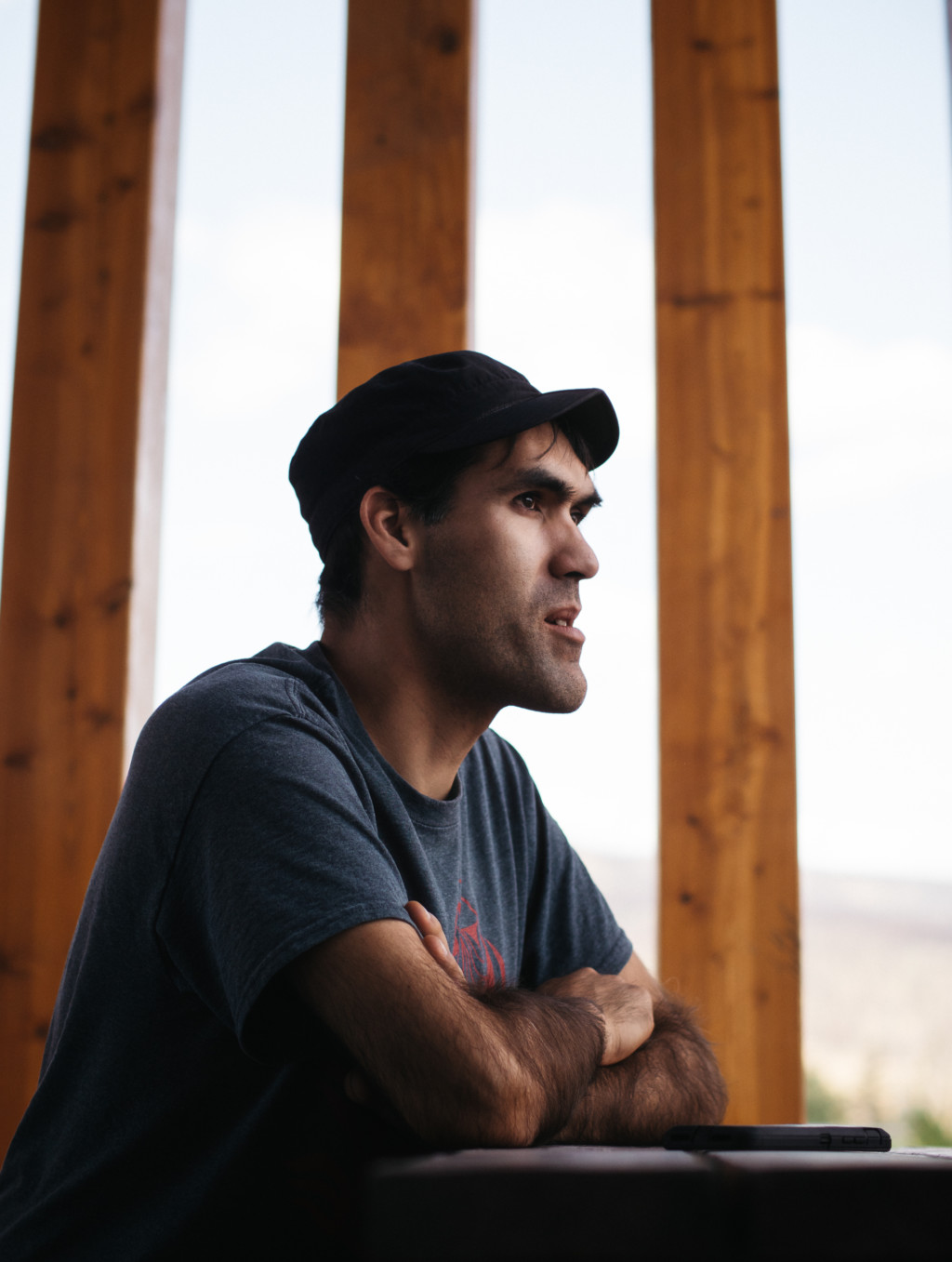
“It was almost like being in a big smudge bowl,” former Yunesit’in Chief Russell Myers Ross says of participating in a cultural burn. Photo: Louis Bockner / The Narwhal
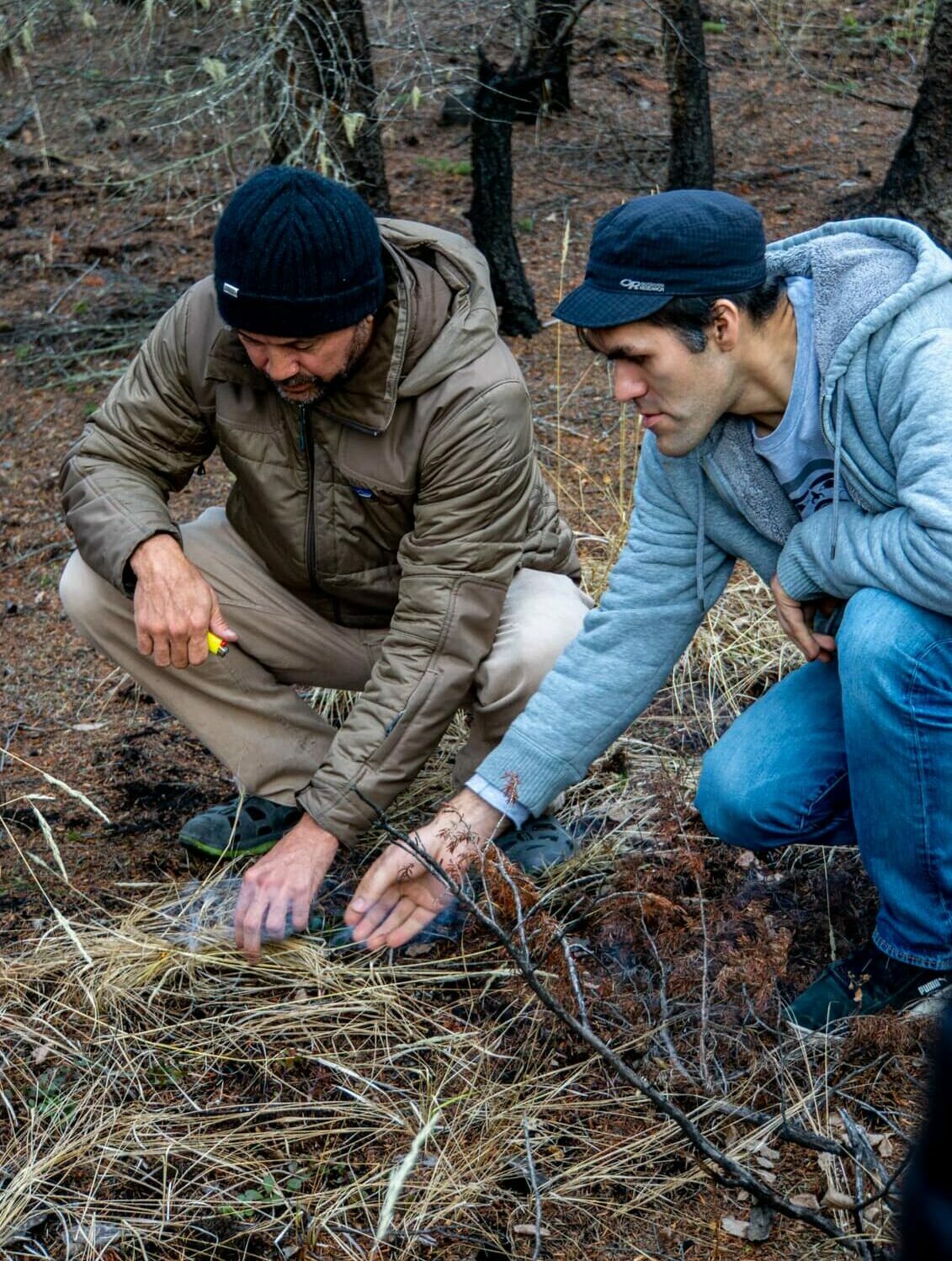
Australian Indigenous fire practitioner Victor Steffensen, left, visits Tsilhqot’in territory to help former Yunesit’in Chief Russell Myers Ross and his community bring back cultural burning. Photo: Ngaio Hotte
“Indigenous burning is … activating the landscape to look after biodiversity, to improve its health,” Steffensen says in a video captured the day of the burn. “It’s to stop it from wildfires and stop the country from burning to nothing.”
Over two weeks in spring 2019, the group lit several fires under Steffensen’s guidance as part of a pilot project to develop a traditional fire management program for Tsilhqot’in lands and the Dasiqox Tribal Park area. The project — which is being led by the Yunesit’in and Xeni Gwet’in First Nations, communities within the Tsilhqot’in Nation, with the support of the Gathering Voices Society — was launched after the 2017 wildfires devastated much of the region and got dangerously close to communities. This got Ross, who is no longer Chief as of Sept. 9, and others thinking about their responsibility to the land and how they can prevent future disasters while revitalizing their traditional cultural practices.
“We are just trying to reinvigorate something that was always within us.”
“We experienced such devastation in 2017,” Ross says, adding that the priority is for the community to recover and prevent any further damage. The cultural exchange with Steffensen — who has spent more than two decades working with Indigenous communities in Australia to revive burning — is key to achieving those objectives.
“We don’t have all the tools that our ancestors did,” Ross says, “but there’s still quite a strong understanding of what the land can take and how it interacts with fires.”
Indigenous Peoples have a long history of purposefully and carefully using fire for cultural and land management purposes. But colonial policies and laws that discouraged or banned burning have created a vacuum of Indigenous fire knowledge, and Indigenous Peoples’ land rights have been severely diminished. Not only that, 80 per cent of Indigenous communities in Canada are located in forests prone to wildfire and climate change is creating longer, harsher and more complex fire seasons.
As historic wildfires rage across the U.S. West Coast — burning millions of hectares, killing dozens of people, driving thousands from their homes and sending smoke all the way to Europe — a continent-spanning conversation about how to better manage the risk is taking place. Meanwhile, a small but mighty contingent of Indigenous people is working to revive cultural burning, which could be part of the solution.
“This is something that’s been done for generations on generations and something that’s been suppressed,” Ross says in the video. “We are just trying to reinvigorate something that was always within us.”
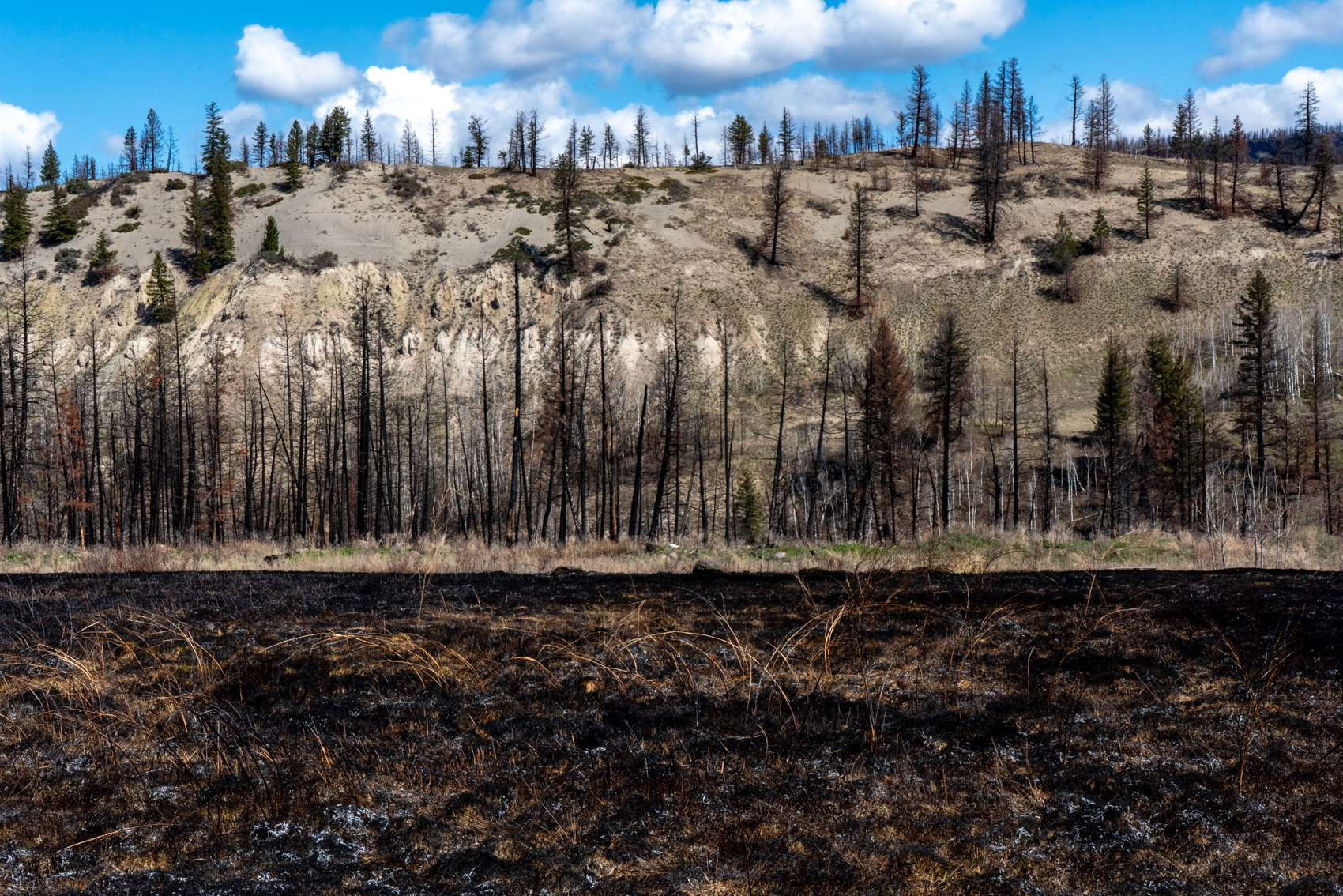
The single largest wildfire in B.C.’s history singed more than 500,000 hectares in the Chilcotin Plateau. Photo: Josh Neufeld / Gathering Voices Society
In 2017, B.C. had one of its worst wildfire seasons ever (outdone only by 2018) and the single largest wildfire in the province’s history. That one fire singed more than 500,000 hectares in the Chilcotin Plateau.
As the blaze tore through the region, the Tsilhqot’in Nation became the first Indigenous nation in Canadian history to exercise its jurisdiction and governance by refusing to leave during a recommended evacuation order, three years after it won Aboriginal title to a vast area of its traditional land in a landmark Supreme Court of Canada ruling. Instead, Tsilhqot’in fire crews successfully defended the homes of the 250 Yunesit’in community members with the help of provincial wildfire crews.
“As a remote nation, we faced extreme challenges, and outside agencies were uneducated about our expertise, our capacity, our governance structures and jurisdiction,” Chief Joe Alphonse, Tribal Chairman of the Tsilhqot’in National Government, says in a government release. “We protected our community from encroaching wildfire while provincial and federal resources were stretched too thin.”
That experience prompted the creation and signing of the Collaborative Emergency Management Agreement between the federal, provincial and Tsilhqot’in Nation governments. Under the agreement, the first of its kind in Canada, the three parties will work together to identify best practices and build on the emergency management capacity of the Tsilhqot’in communities based on lessons learned during the 2017 wildfire season.
“Emergency situations are only going to increase in a time of climate change,” Alphonse says. “This tripartite emergency agreement is just a start to working together as governments and preparing for future emergency situations.”
Bringing back cultural burning is a key part of the way forward.
Cultural burns are different from planned and controlled burns called “prescribed fires,” which are executed by government forest managers. Prescribed fires are primarily done to get rid of built-up “fuel” — from needles, grasses and twigs to shrubs, fallen branches and downed trees — and reduce the risk of uncontrolled wildfires.
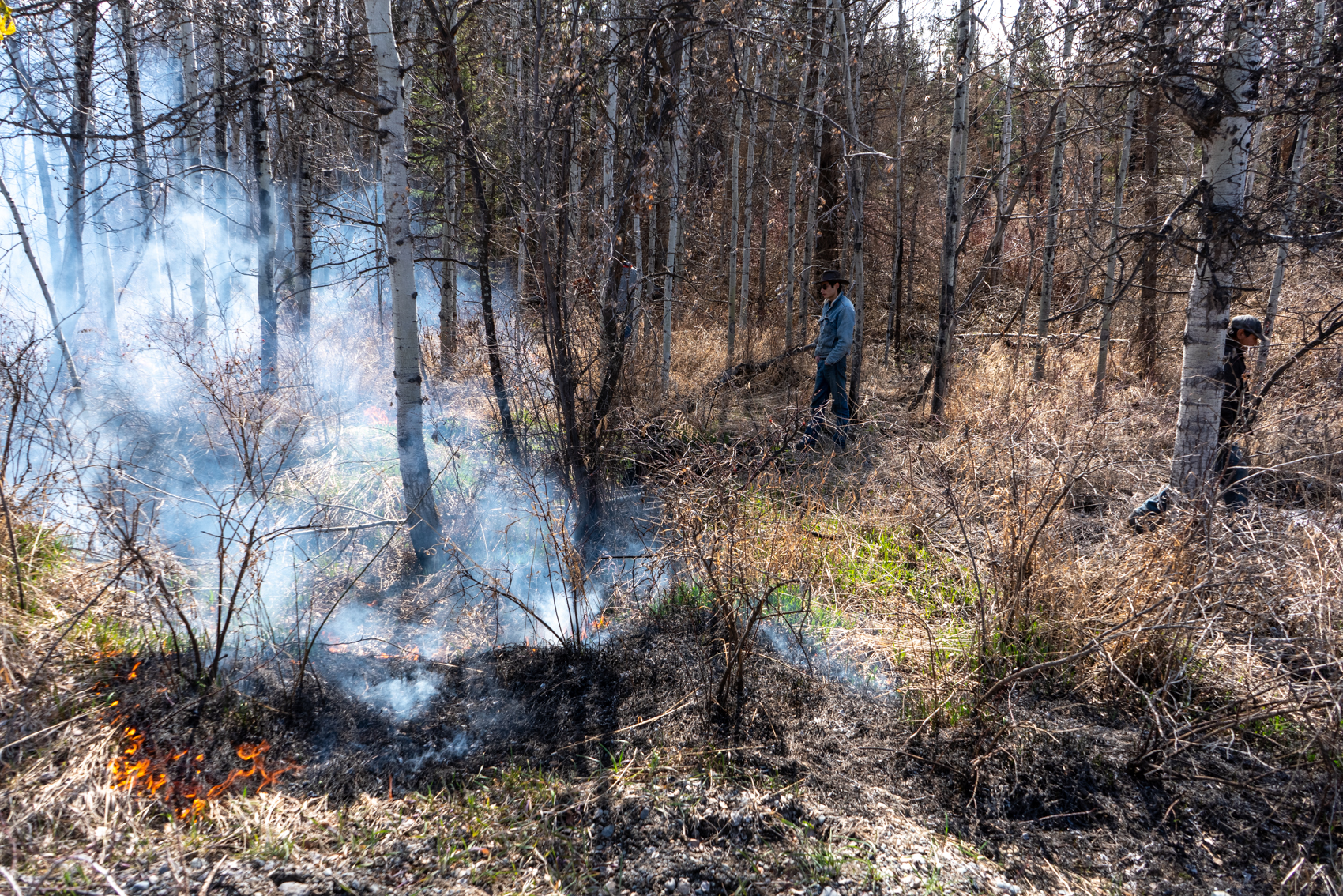
Cultural burns are different from prescribed fires. Their primary purpose is to fortify the land rather than reduce the risk of wildfires. Photo: Josh Neufeld / Gathering Voices Society
Cultural burns, on the other hand, are done to fortify the land. Reducing the risk of wildfires is but one of the benefits of cultural burns, which aim to promote the growth of medicinal and food plants, such as mushrooms, berries and wild onions, and maintain the landscape for all species.
“Activating landscape is also having that right fire so that the seeds grow and the berries grow and the animals come back,” Steffensen says in the video. “The whole idea of this is to activate landscapes to bring it back to life, to connect people back to that and to show that interrelationship and responsible role that people have inherited over thousands of years.”
Both prescribed and cultural burns reduce wildfire risk. A recent article published in the journal Nature Communication says “prescribed burning programs in boreal forests would reset the stand age and effectively reduce wildfire potential for decades to come,” but points out that residents and decision-makers still find the practice risky. In Australia, fire prevention programs involving cultural burning, primarily on Aboriginal lands in northern Australia, have cut destructive wildfires in half and reduced greenhouse-gas emissions from wildfires in the north by 40 per cent, according to a story published in the New York Times
.
“Indigenous knowledge systems were designed to keep ecosystems healthy so that [people] could survive,” says Amy Cardinal Christianson, a Metis woman who was raised in Treaty 8 territory and who is a fire research scientist with the Canadian Forest Service. “Their survival was intricately linked to the health of the forest, not like now where many are so disconnected. If you did a burn improperly in your territory, it could have huge implications — you might not be able to get enough food to survive the winter.”
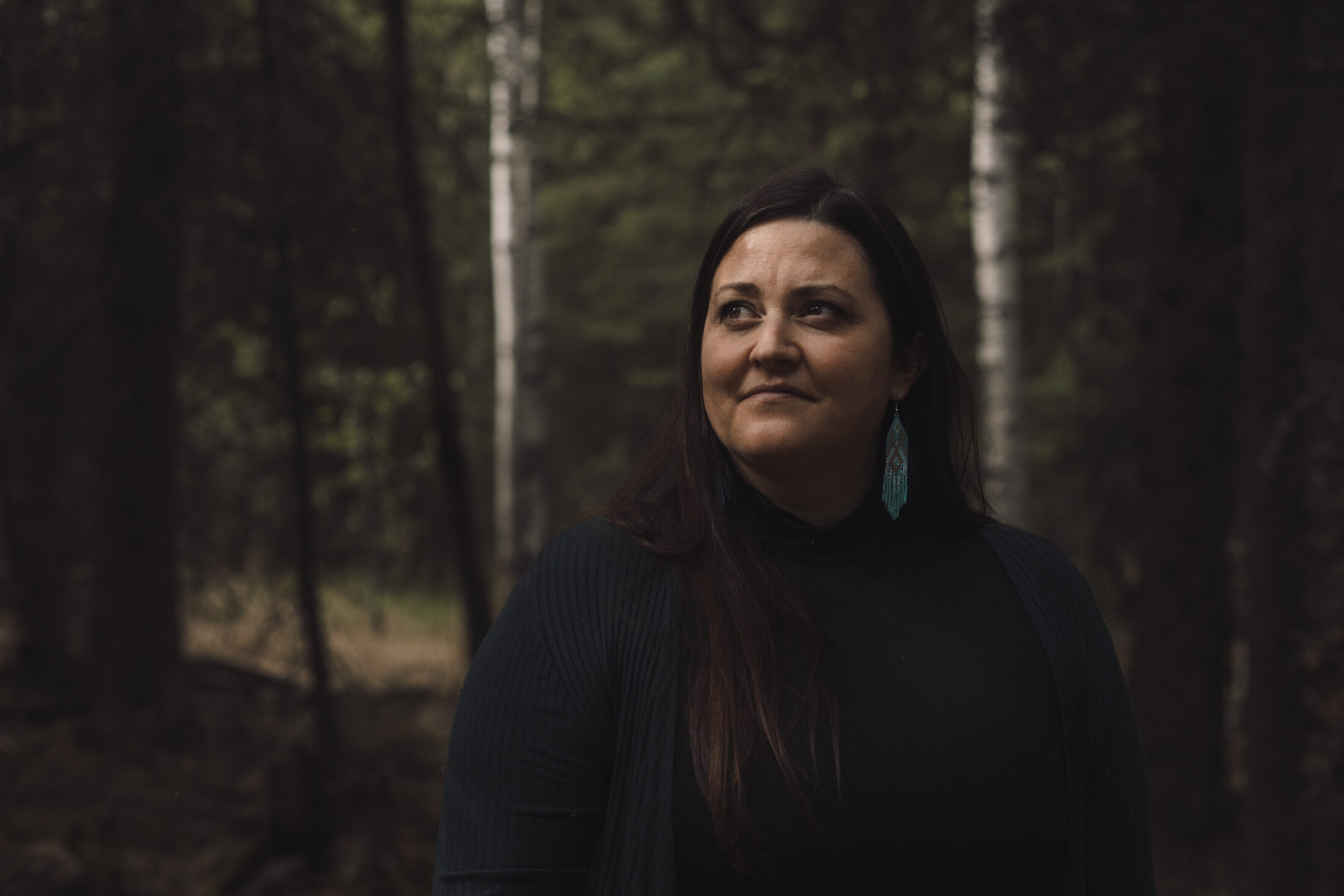
Amy Cardinal Christianson in the forest on her family property near Rocky Mountain House, Alta. Photo: Amber Bracken / The Narwhal
Cultural burns need precise seasons and weather conditions to take place. “Cultural burns are different depending on the objective, but most are low intensity, slow burns that are conducted when the wildfire risk is low, generally the spring or summer,” says Christianson, who hosts a podcast called Good Fire. (Each episode examines a different aspect of “good fire” — fire that is lit intentionally with an ecological or cultural goal in mind — and speaks with experts from around the globe.)
“Indigenous people tend to know the time to burn by looking for cues in their territory,” she continues. “Are deer coming to the area or is it hard for them to get through the forest because of undergrowth? Do the Saskatoon bushes seem healthy with large plump berries or are the bushes too large and overgrown?”
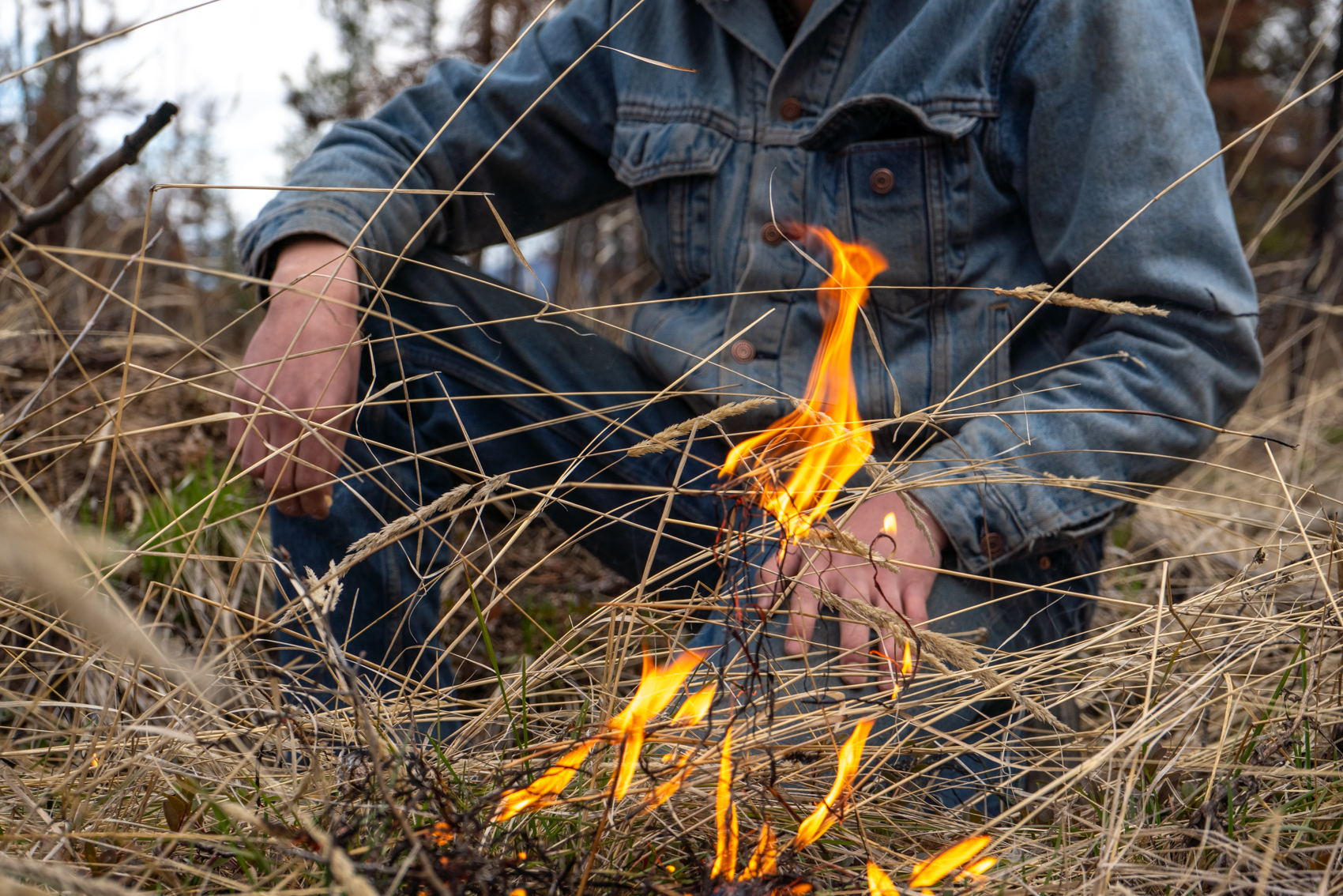
Indigenous people know the right time to burn by looking for cues in the ecosystem. Photo: Josh Neufeld / Gathering Voices Society
When he was a kid, Duane Hink, a Yunesit’in fire practitioner who is participating in the Tsilhqot’in project, recalls seeing raspberries in every gully. Over the years, he’s watched the landscape change dramatically, to the point where visiting relatives are in tears because they don’t recognize it. “I just want to see a healthy land again,” he says in the video.
Cultural burns also bring people together to practise their culture. In the past, it was an activity the whole family did together, even children, who would pick up pine cones that were on fire and throw them ahead to make the fire move. Unfortunately, this has rarely happened in Canada since governments decided cultural burning was a crime.
When Joe Gilchrist, a traditional burning knowledge keeper from the Skeetchestn Indian Band in central B.C., was a young boy, he often went hunting with his grandfather. As they hiked side by side up the hill toward the lake, his grandfather would light fires, explaining to young Joe that the grassy areas where deer are born should be burned so they can have fresh food, be free of ticks and see predators before it’s too late. But on their way down, they would see government firefighters extinguishing the flames.
“He would say, ‘I wish they would just let it burn. It won’t go anywhere but up the hill. It’s spring time and will just go out on its own,’ ” Gilchrist recalls in an interview as part of a First Nations Emergency Services Society project. “But at that time, it was illegal to burn.”
B.C. became the first province to ban cultural burns with the Bush Fire Act of 1874 in B.C., with other provinces following suit in the early 1900s. Similar to the Potlatch ban, which the federal government implemented in 1884, the burning ban aimed to remove ceremony and assimilate Indigenous Peoples.
In B.C. in the early 1900s, a chief fire warden and fire rangers suppressed forest fires and spread the messages of fire prevention by posting notices at trading posts translated into “Indian” languages — “Cree and Chipewyan” — according to the 1911 Report of the Superintendent of Forestry. People caught burning were subject to a $100 fine — the equivalent of about $2,200 today — or three months in prison.
Indigenous people were also threatened and coerced into not burning. In a letter to Governor James Douglas, British Army officer Walter Colquhoun Grant complained about cultural burns and detailed his actions to stop them, according to “Time to Burn,” a chapter by ethnobotanist Nancy Turner in the book Indians, Fire, and the Land.
“Their object is to clear away the thick fern and underwood in order that the roots and fruits on which they in a great measure subsist may grow the more freely and be the more easily dug up. I have endeavoured … to check these fires by giving neither potlatch [gifts] or employment to any Indians so long as a fire was blazing in sight of my house.”
“We forget the good food of our earliest forefathers.”
Turner’s chapter also details intimidation in Eastern Canada. In a major address to the 1884 Montreal meeting of the British Association for the Advancement of Science, famous geologist Robert Bell suggested Indigenous people could be inhibited from burning through economic incentives and disincentives, such as withholding their annuities as a punishment for carrying out burns or paying a bounty each year that no fires occur.
Turner reports that the Wet’suwet’en and Gitxsan Peoples of B.C. used controlled burns to boost the productivity of their berry patches, and the last such burns happened roughly between 1930 and 1940 as the B.C. Forest Service ramped up fire suppression efforts. Turner notes that the Forest Service offered rewards for any tips on cultural burns and made several convictions.
A comment from Lil’wat Elder Baptiste Richie, recorded by Nancy Turner in 1969, details the impact of the campaign against burning: “If you go to burn then you get into trouble because the white men want to grow trees. Because they changed our ways they do good for us and we eat the food that the white men use. Then we forget the good food of our earliest forefathers. … Now they have all disappeared because the hills grew weedy and no one seems to tend them, no one clears them as our forefathers did so thoroughly.”
Decades of fire suppression has led to an accumulation of wildfire fuel, slow and diseased tree growth and a loss of cultural practices. The wildfires that have burned as a result of this have released untold tonnes of carbon into the atmosphere. In addition, climate change is creating more frequent wildfires, particularly in the Canadian northwestern boreal regions, by altering the patterns of lightning, fuel moisture, temperature and precipitation.
Jeff Eustache, manager of the forest fuel management department at the First Nations’ Emergency Services Society of B.C., says without cultural burns, mountain pine beetle infestations created huge swaths of dead trees, which led to massive wildfires.
“I don’t think the government would really acknowledge [it], but they created some issues with forest health [that] naturally fires would cleanse,” he says.
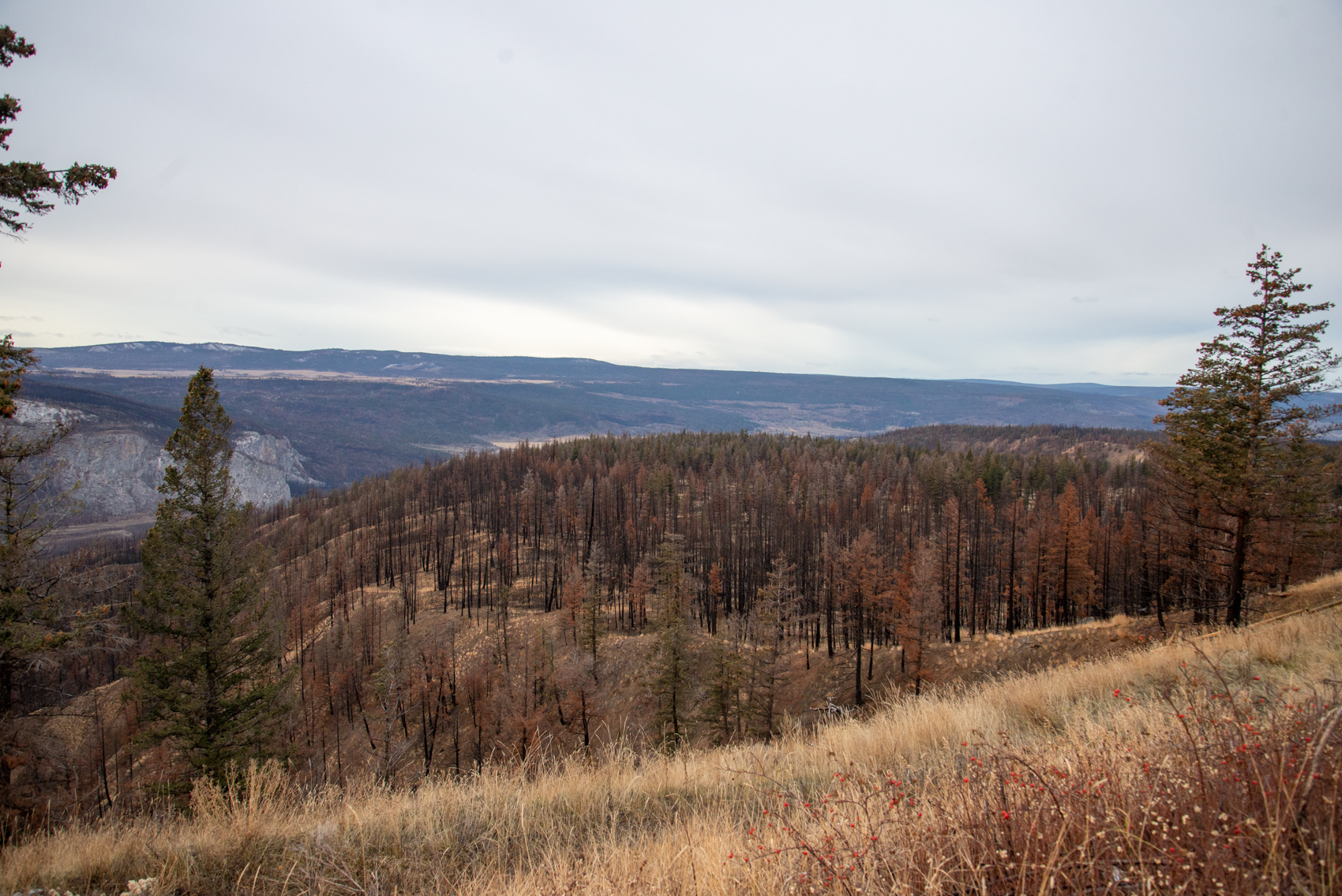
It will take several years for Tsilhqot’in lands to regenerate — if they do — following the devastating 2017 wildfire. Photo: Josh Neufeld / Gathering Voices Society
Eustache says the B.C. landscape has changed so much that its ability to regenerate itself has deteriorated. “It’s slowly starting to come back but historically that would’ve come back around quicker.”
Because of the laws against putting fire on the land, many Indigenous people started working in fire suppression in the 1960s and 1970s. With this came a shift in thinking about fire.
“When you can’t burn and you can’t teach your kids to burn, and then they become firefighters, eventually the pendulum swings from seeing fire as good to seeing fire as bad,” Christianson says. “Add in climate change, and folks become very nervous to burn.”
While some communities have a fire keeper with vast traditional knowledge, other communities’ “relationship with fire as a medicine has been totally severed,” says Christianson, adding that they need funding or education programs to learn about fire to ensure the knowledge stays alive.
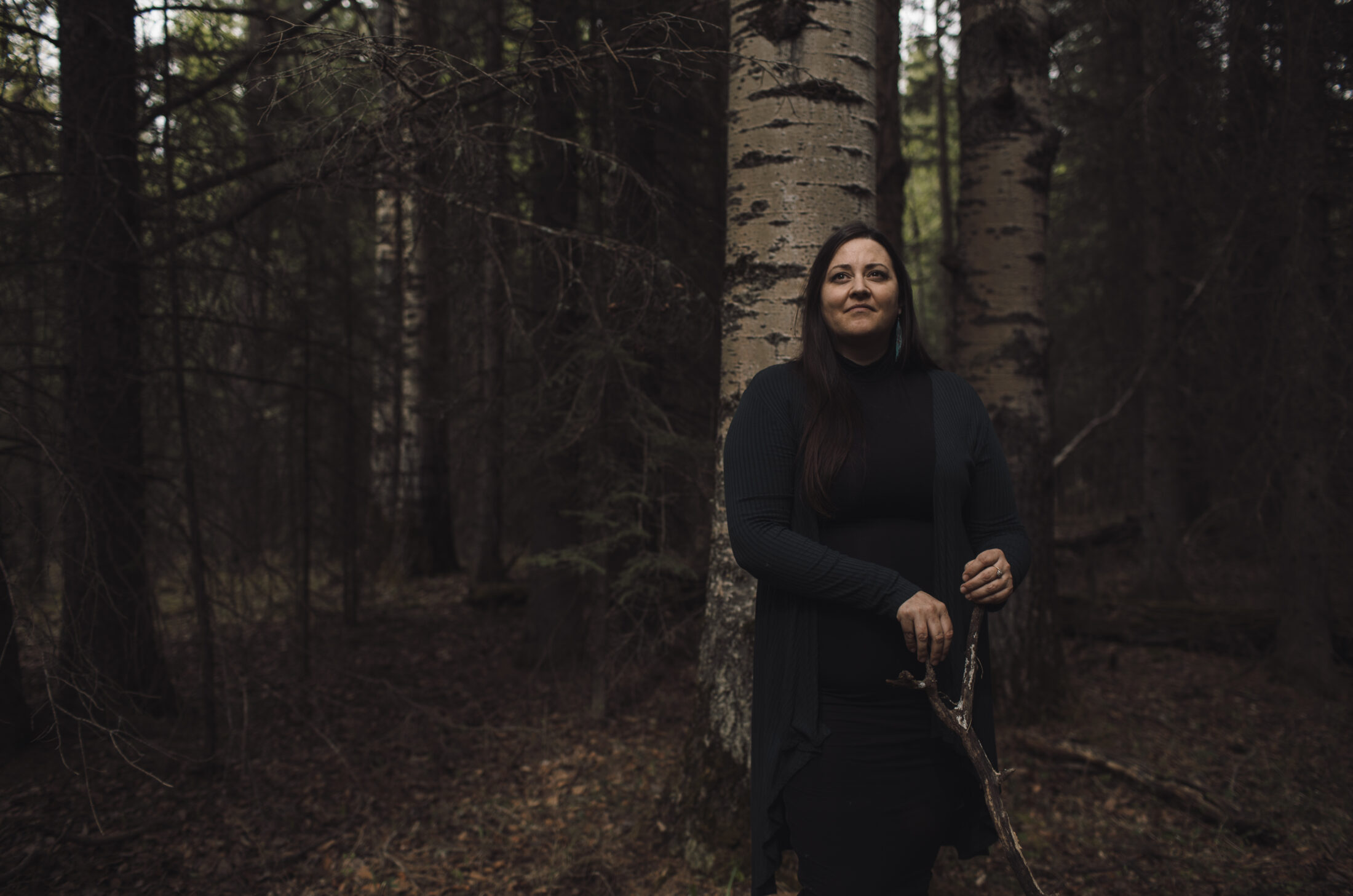
Christianson says the relationship with fire as a medicine has been severed in many Indigenous communities. Photo: Amber Bracken / The Narwhal
The Tsilhqot’in project will continue for three more years, bringing Steffensen back each year to continue guiding the group on cultural fire management. The project also involves developing a program to sell carbon credits on the carbon market. This is already being done in Australia, where carbon credits are calculated by measuring the emissions from early-season cultural burns against emissions from late-season wildfires. In Australia, these early-season fires have saved millions of tonnes of carbon from being released into the atmosphere and generated annual revenues of around $40 million.
Perhaps most importantly for the Tsilhqot’in Peoples, the project involves implementing a traditional wildfire management program on a larger scale. “My intention is that we can scale up at some point and have a lot more people involved, mapping out the whole territory, and being able to apply fire at different times of the year to ensure that we prevent massive forest fires again,” Ross says.
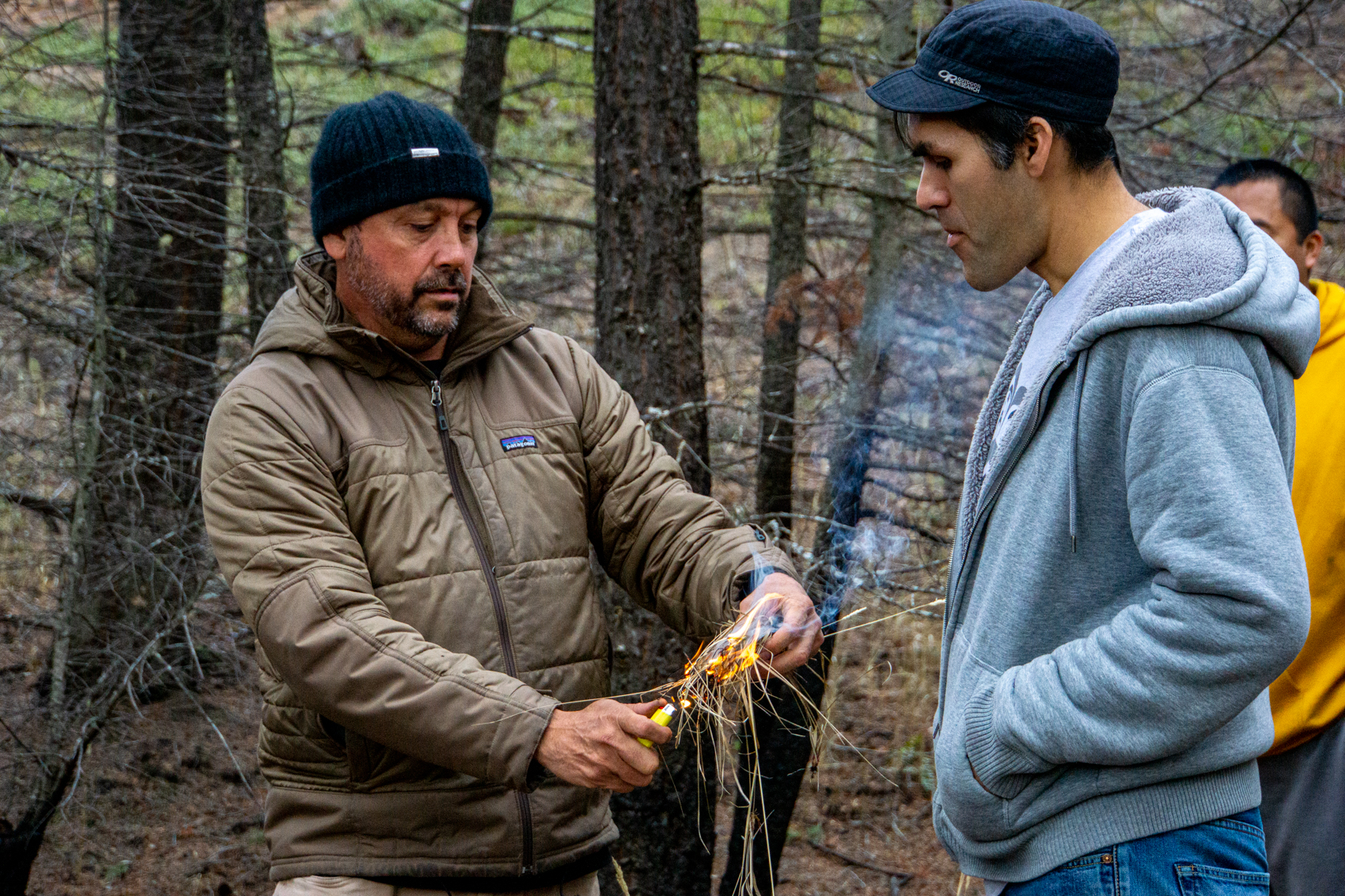
Victor Steffensen, left, will return to the Tsilhqot’in Nation for several years as part of a pilot project to revive cultural burning in the region. Photo: Ngaio Hotte
Meanwhile, Eustache, Christianson and the First Nations’ Emergency Services Society have been working on a project called Revitalizing Traditional Burning, which involves gathering stories about cultural burning from Elders and knowledge keepers from the Shackan Indian Band, the Xwisten (Bridge River) First Nation and the Yunesit’in. The goal is to come up with a burn plan for each community, which will include its objectives, a list of resources, maps and information on how to carry out a burn. They also established the Xwisten Fire Council, which brings Xwisten Elders with burning knowledge together once a month.
Christianson says bringing people together to discuss burning is about nation building as well as the craft. “It’s about taking pride, being caretakers and stewards of the lands and it’s also great for people to get out on the land in terms of health.”
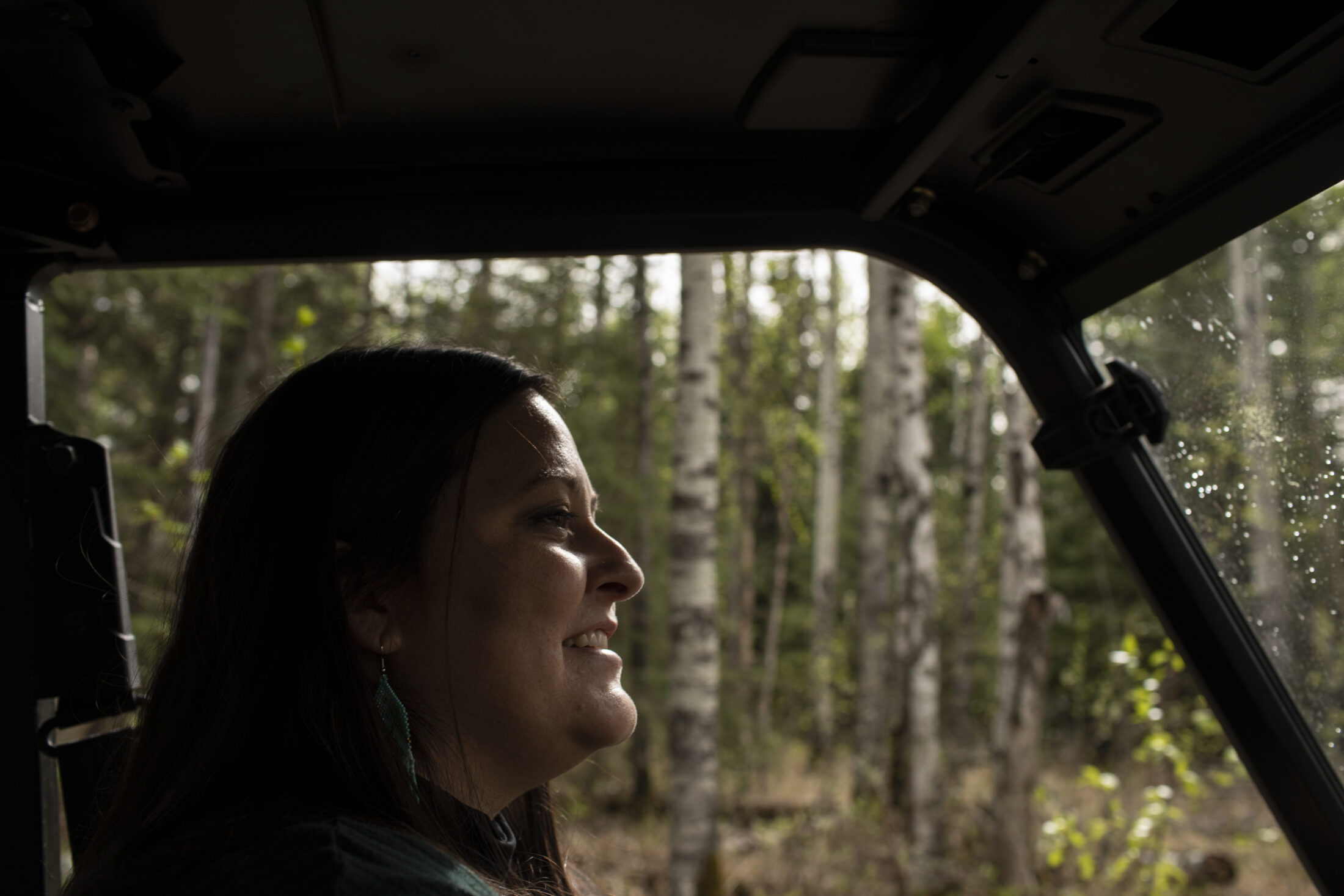
Christianson says cultural burning is “about taking pride, being caretakers and stewards of the lands.” Photo: Amber Bracken / The Narwhal
Despite these new initiatives in B.C., Christianson is frustrated by how far behind other countries Canada is and would like to see a national strategy on cultural burning.
An article in the journal Geographical Research found that Canada, the U.S., Australia and New Zealand are engaging with Indigenous Peoples on cultural knowledge related to natural hazard and emergency management, but legal changes rarely result. Instead, the outcomes are policy commitments (which can change), collaborative capacity-building or “multi-stakeholder schemes” related to common law changes about land rights.
Australia, for instance, has a national wildfire management policy with the goal to promote Indigenous Australians’ use of fire and building employment opportunities for Indigenous communities working in land and wildfire management.
In Canada, efforts are localized and siloed, with strategic partnerships often formed between Indigenous communities and local organizations or forest rangers.

A cultural burning trainee puts out a fire under the watchful eye of Victor Steffensen. Photo: Josh Neufeld / Gathering Voices Society
Despite the fact that many Indigenous people are in the firefighting industry, Christianson sees few in leadership roles. “This creates a major issue on the fire line,” she says. “For example, you might have an Indigenous person who has been firefighting for 30 years — and I’ve met a lot of them — and is incredibly knowledgeable from vast and varied fire experiences,” she says. “But his boss may be a 22-year-old from an urban area who just graduated with a technical diploma and has never even seen a fire.”
If more Indigenous people were in leadership roles, the landscape could look very different, Christianson says.
“Cultural burning should be an opportunity for Indigenous people to manage their territories,” she says. “What generally happens is that government agencies want to come in and [learn about cultural burning], and basically on paper they are supportive, but when it comes down to burning and who’s lighting the match, that’s quickly when the power shifts.”
Today, Indigenous Peoples can have cultural burns on reserves and on title lands (in the case of Tsilhqot’in) without provincial approvals. This works out well for northern communities with large reserves, Christianson says, but can be challenging for smaller reserves that want to manage the surrounding lands but don’t have jurisdiction to do so — even though it’s their territory.
Burning next to urban centres complicates things further. Oftentimes, people from neighbouring non-Indigenous communities see smoke and call it in, complying with wildfire agencies’ procedures.
Christianson says wildfire agencies want people to call in suspected wildfires, but the issue is what happens next. In some cases, the fire department or fire management agency will let the band complete the burn or join in to help. Other times, they will demand the burn be extinguished.
“Generally, wildfire management agencies like to be informed of all burns happening in their region,” says Christianson. “But some First Nations do not agree with having to ask permission or report what they are doing on their territory, so it comes down to questions about ownership and governance.”
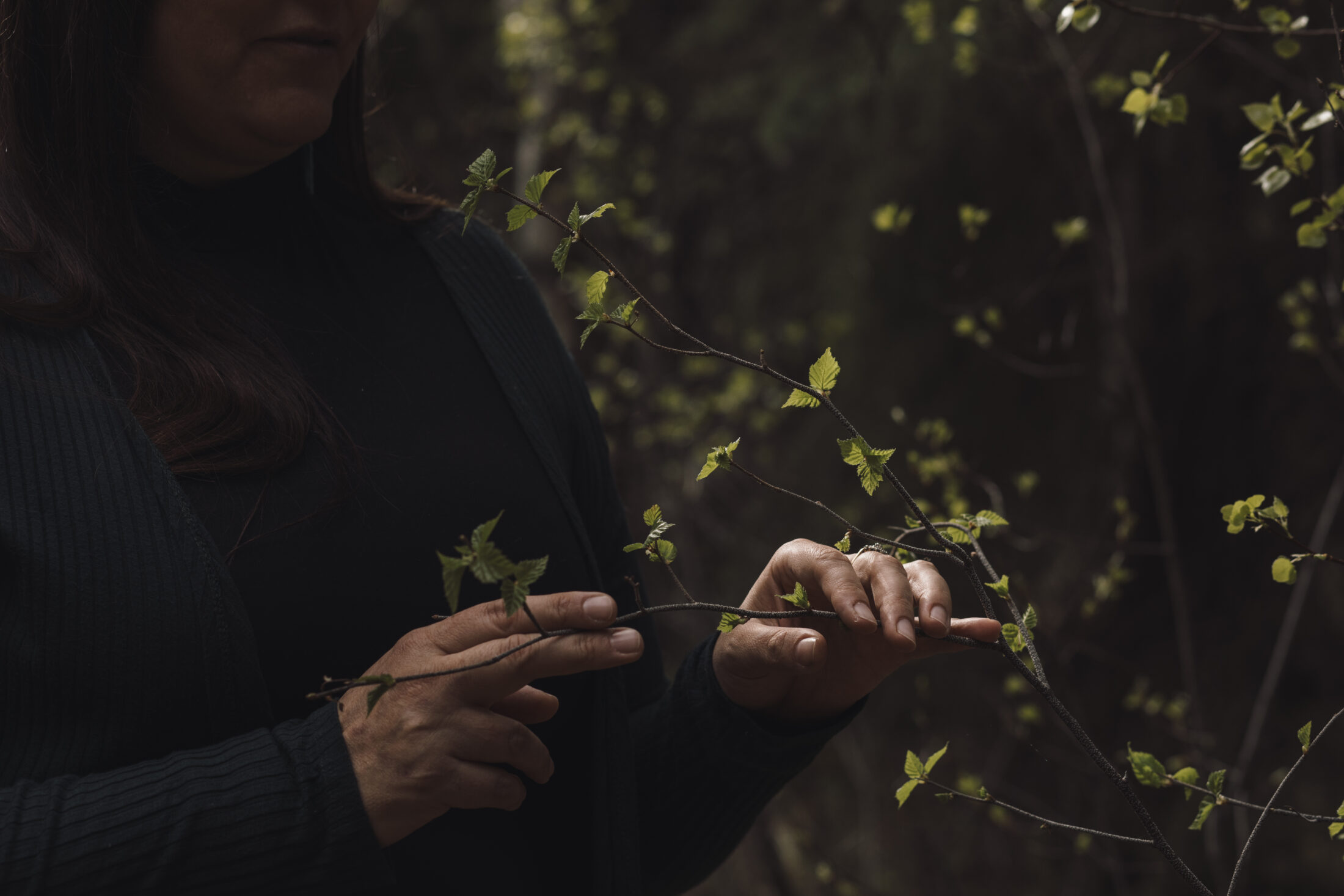
Issues over jurisdiction are a barrier for many Indigenous Peoples when it comes to cultural burning, Christianson says. Photo: Amber Bracken / The Narwhal
Back at the Tsilhqot’in burn, trainees wearing backpack sprayers douse the embers and take stock of their handiwork. As the smoke dissipates, several deer come into the area, possibly in search of some of that freshly revealed tasty green grass. “Their instincts are showing,” Hink says in the video.
It’s also a hopeful sign the Tsilhqot’in are on the right track.
As Steffensen hands each of the trainees a pack of matches, the excitement is palpable.
“Bring fire back to the people!” one participant yells.
“The power is yours!” calls another.
It’s clear the benefits of bringing back cultural burning are emotional as well as ecological.
Several studies in Australia show that participating in Indigenous land management such as cultural burning enhances well-being and physical and mental health. A 2018 study, for instance, found that participating in Indigenous land management empowers people, strengthens their sense of identity and allows them to foster important relationships with members of their community. It also provides access to traditional foods and promotes physical activity. Another study found that Indigenous land management is significantly associated with a lower risk of heart disease, diabetes and psychological distress.
“You gotta take this on because this is your culture,” Steffensen says in the video. “This is the medicine for social problems, it’s the medicine for environmental problems and it’s the medicine to build the broader community together and evolve culture together.”
This article was produced through The Narwhal’s Indigenous Journalism Fellowship, made possible by the generous support of the Reader’s Digest Foundation.
Updated Sept. 22, 2020, at 10:15 a.m. PST: This article was updated to add that Russell Myers Ross is not longer Yunesit’in Chief as of Sept. 9, 2020.
Get the inside scoop on The Narwhal’s environment and climate reporting by signing up for our free newsletter. On a warm September evening nearly 15...
Continue reading
Climate change, geopolitics and business opportunities power a blue economy

10 billion litres of sewage are dumped into Winnipeg’s lakes and rivers each year. Some...

Court sides with Xatśūll First Nation, temporarily halting Mount Polley mine waste expansion
